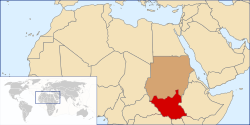| Southern Sudan Autonomous Region | |||||||||
|---|---|---|---|---|---|---|---|---|---|
| Autonomous region of Sudan | |||||||||
| 1972–1983 | |||||||||
 Map showing Southern Sudan (red) within Sudan (darker brown). | |||||||||
| Capital | Juba | ||||||||
| Area | |||||||||
• 1983 | 619,745 km2 (239,285 sq mi) | ||||||||
| Population | |||||||||
• 1983 | 5,466,700 | ||||||||
| Government | |||||||||
| • Type | Autonomous region | ||||||||
| President of the High Executive Council | |||||||||
• 1972–1978 (first) | Abel Alier | ||||||||
• 1982–1983 (last) | Joseph James Tombura | ||||||||
| Legislature | People's Regional Assembly | ||||||||
| History | |||||||||
| 28 February 1972 | |||||||||
• Autonomy abolished | 5 June 1983 | ||||||||
| |||||||||
| Today part of | |||||||||
The Southern Sudan Autonomous Region was an autonomous region that existed in southern Sudan between 1972 and 1983. [1] It was established on 28 February 1972 by the Addis Ababa Agreement which ended the First Sudanese Civil War. [2] The region was abolished on 5 June 1983 by the administration of Sudanese President Gaafar Nimeiry. [3] Revocation of southern autonomy was one of the causes of the Second Sudanese Civil War which would continue until January 2005, when southern autonomy was restored; the region became the independent Republic of South Sudan in 2011.


